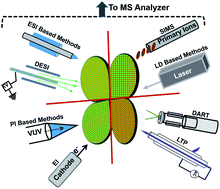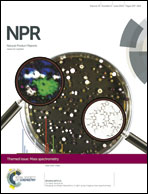Ion sources for mass spectrometric identification and imaging of molecular species
Abstract
Covering: 2013
The ability to transfer molecular species to the gas phase and ionize them is central to the study of natural products and other molecular species by mass spectrometry (MS). MS-based strategies in natural products have focused on a few established ion sources, such as electron impact and electrospray ionization. However, a variety of other ion sources are either currently in use to evaluate natural products or show significant future promise. This review discusses these various ion sources in the context of other articles in this special issue, but is also applicable to other fields of analysis, including materials science. Ion sources are grouped based on the current understanding of their predominant ion formation mechanisms. This broad overview groups ion sources into the following categories: electron ionization and single photon ionization; chemical ionization-like and plasma-based; electrospray ionization; and, laser desorption-based. Laser desorption-based methods are emphasized with specific examples given for laser desorption postionization sources and their use in the analysis of intact microbial biofilms. Brief consideration is given to the choice of ion source for various sample types and analyses, including MS imaging.

- This article is part of the themed collection: Mass Spectrometry of Small Molecules and Natural Products

 Please wait while we load your content...
Please wait while we load your content...